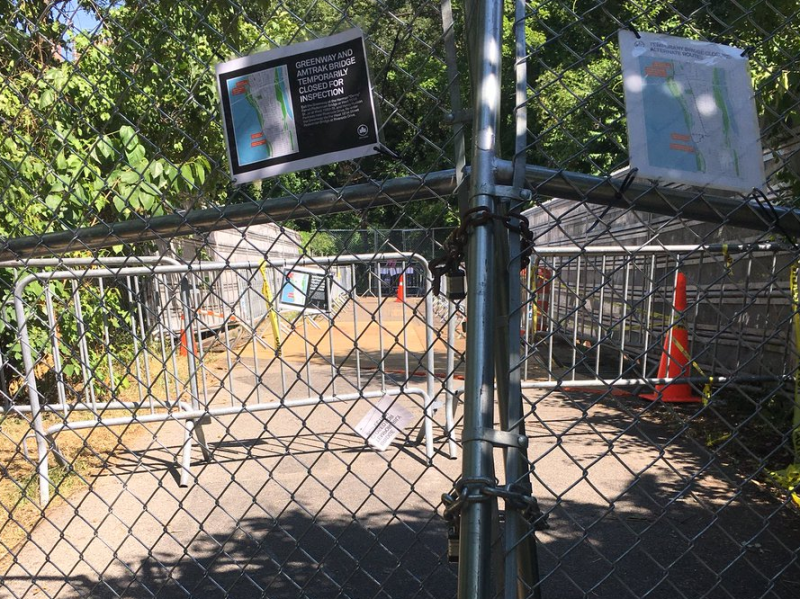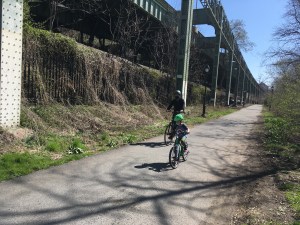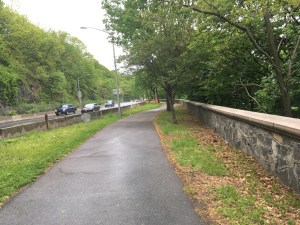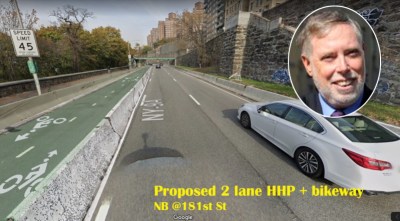Ineptitude, Delays and Apathy Could Rob Upper Manhattan and the Bronx of Key Bike Routes
Come October, the Henry Hudson Bridge, Dyckman Street, and a key Greenway link could all be out-of-commission.

Safe cycling routes to Inwood and the Northwest Bronx could soon be harder to find thanks to decisions by city and state agencies that will neutralize key links along and around the northernmost segment of the Hudson River Greenway.
Last month, the Parks Department fenced off access to the greenway’s Fort Washington Park pedestrian bridge so it could conduct “immediate” — but still unscheduled — repairs. A few miles north, the state-run MTA plans to cut off walking and biking access on the Henry Hudson Bridge, the only safe non-auto crossing between Inwood and the northwest Bronx. Meanwhile, the city announced last month it would rip up one of Dyckman Street’s nine-month-old protected bike lanes (though that decision is being revisited).

Local biking advocates are furious.
“It’s been kind of a 1-2-3 punch for us uptown cyclists,” said Inwood resident Orin Kurtz. “Literally the day they closed the [Fort Washington Park] bridge, they took off the bike lane on Dyckman.”
The Henry Hudson Bridge foot and bike path closure will begin on September 20, according to signage posted at the bridge entrance. The $86-million rehabilitation project is expected to last 19 months.
The MTA plans to provide shuttle buses over the bridge every half hour between 7 a.m. and 9 p.m. during the closure. But that won’t do much for either greenway-bound bike commuters or Bronxites who want to get to Inwood Hill Park by foot or bike: Waiting for and riding the shuttles is certain to make the trip at least 15 minutes longer. At that rate, die-hard cyclists might as well take the treacherous Broadway Bridge. Others will probably give up altogether.
“If you’re taking your child for a bike ride to see Inwood Park or the greenway, you’re not going to get on a shuttle,” said Riverdale resident Craig Weingard. “It’s absolutely ridiculous. No one is going to do that.”
“That Broadway Bridge — charitably speaking, it’s a nightmare,” Kurtz said.
Weingard and Bronx Community Board 8’s transportation committed pushed for safe space for biking and walking during bridge construction after MTA started talking about this rehab project in 2016 [PDF]. The MTA rejected that as unsafe to bridge users and construction crews.
“In order to keep the public safe, the walkway needs to be closed,” MTA Maintenance Superintendent Richard Campisi told the Riverdale Press last year. Other agency reps told CB8 that car volumes on the bridge were too high and bike volumes too low to warrant re-purposing a lane for walking and biking.
“There’s a simple — simple, simple, simple — solution,” said Weingard. “If somebody can make it safe for the workers, if somebody can make it safe for cars, then you can make it safe for pedestrians and cyclists as well.”
Further south, the Parks Department has yet to provide a timeline for when repairs will begin on the Fort Washington pedestrian bridge — or how long those repairs will take. On Twitter, some have speculated that the bridge could be out-of-commission for a long time. A complete reconstruction project, originally proposed in 2009, is long overdue.
Heads up #bikenyc. The #hudsonrivergreenway detour is now mulch and unrideable. Parks workers told me it would be years before the #amtrakbridge would be fixed because the entire bridge structure needs to be replaced. Can you confirm this officially @NYCParks ? pic.twitter.com/9D8sThSKRW
— Armenoush (@armenoush_nyc) September 7, 2018
Park Department officials suggest cyclists take 181st Street as an alternative, but that route requires navigating steep inclines. Some commuters have instead opted to ride on a poorly kept path in the park, which requires traversing an emergency highway service ramp. In response, Parks covered the path with mulch — supposedly to improve conditions for commuters. Stairs on the southern end of the detour will soon be equipped with rails to assist cyclists carrying their bikes.
“We are aware that regular commuters familiar with this bridge have been using it as an alternate detour,” said Parks spokesperson Crystal Howard. “As such, we have pruned the perimeter of the pathway; done some patchwork to potholes, where able; and mulched the path to cover tree roots and depressions so it’s more conducive to pedestrian access.”
Scott Baker, a Midtown resident who organizes bike rides for the East Coast Greenway Alliance, said the detour is too steep for participants. The 181st Street alternative, however, isn’t much better.
“It’s a huge hill,” Baker said. “It actually gets steeper as you go higher, so a lot of people end up walking [their bikes].”



